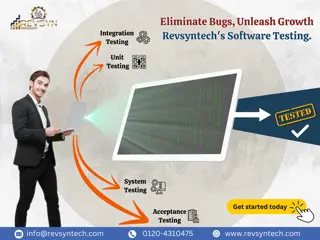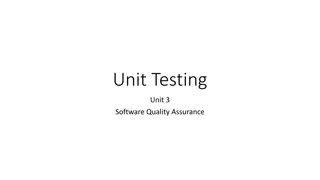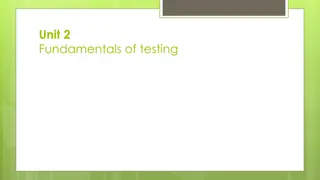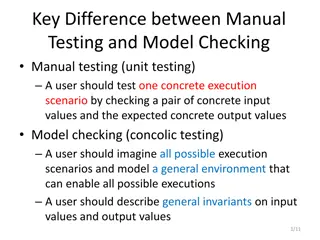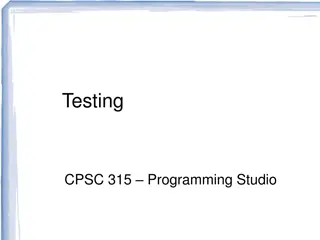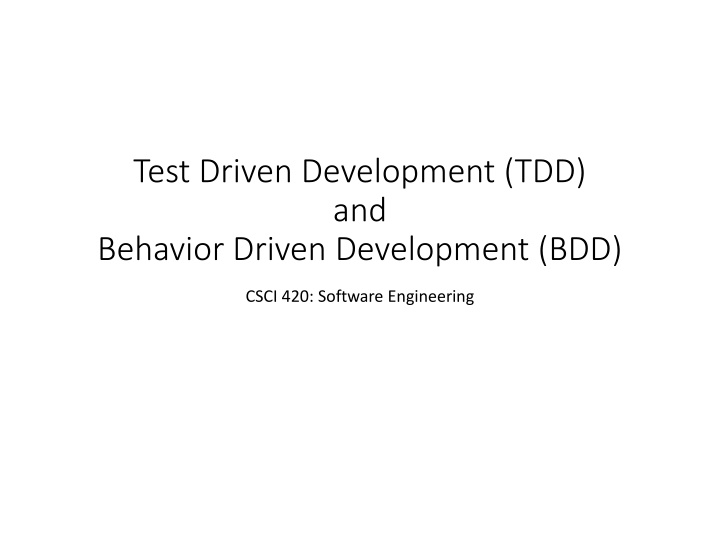
Test-Driven Development Principles
Explore the concepts of Test-Driven Development (TDD) and Behavior-Driven Development (BDD) in software engineering, Agile methodologies, and the importance of writing tests before code. Discover how these practices lead to more cohesive and less coupled code, as advocated by Kent Beck.
Download Presentation

Please find below an Image/Link to download the presentation.
The content on the website is provided AS IS for your information and personal use only. It may not be sold, licensed, or shared on other websites without obtaining consent from the author. If you encounter any issues during the download, it is possible that the publisher has removed the file from their server.
You are allowed to download the files provided on this website for personal or commercial use, subject to the condition that they are used lawfully. All files are the property of their respective owners.
The content on the website is provided AS IS for your information and personal use only. It may not be sold, licensed, or shared on other websites without obtaining consent from the author.
E N D
Presentation Transcript
Test Driven Development (TDD) and Behavior Driven Development (BDD) CSCI 420: Software Engineering
Agile Lifecycle Review Work closely, continuously with stakeholders to develop requirements, tests Users, customers, developers, maintenance programmers, operators, project managers, Maintain working prototype while deploying new features every iteration Typically every 1 or 2 weeks Instead of 5 major phases, each months long Check with stakeholders on what s next, to validate building right thing (vs. verify)
BDD+TDD: The Big Picture Behavior-Driven Design (BDD) develop user stories (the features you wish you had) to describe how app will work via Cucumber, user stories become acceptance tests and integration tests Test-Driven Development (TDD) step definitions for a new story, may require new code to be written TDD says: write unit & functional tests for that code first, before the code itself that is: write tests for the code you wish you had
My Zune is a Brick year = ORIGINYEAR; /* = 1980 */ while (days > 365) { if (IsLeapYear(year)) { if (days > 366) { days -= 366; year += 1; } } else { days -= 365; year += 1; } } Midnight 12/31/2008
Quotes Kent Beck said Test-first code tends to be more cohesive and less coupled than code in which testing isn t a part of the intimate coding cycle [2] If you can t write a test for what you are about to code, then you shouldn t even be thinking about coding [2]
TDD Overview (1 of 3) Made popular by Extreme Programming Method of developing software not just testing software Software is Developed in short iterations Unit Tests are developed FIRST before the code
TDD Overview (2 of 3) 1. How It Works Add a Test Use Cases / User Stories are used to understand the requirement clearly Run all tests and see the new one fail Ensures test harness is working correctly Ensures that test does not mistakenly pass Write some code Only code that is designed to pass the test No additional functionality should be included because it will be untested 2. 3. [4]
TDD Overview (2 of 3) 4. Run the automated tests and see them succeed If tests pass, programmer can be confident code meets all tested requirements Refactor code Cleanup the code Rerun tests to ensure cleanup did not break anything Repeat 5. [4]
Test First vs. Test Last Pick a piece of functionality Write a test that expresses a small task that fails Write production code until test passes Run all tests Rework code until all tests pass Repeat [1] Pick a piece of functionality Write production code that implements entire functionality Write tests to validate all functionality Run all tests Rework code until all tests pass [1]
Test First vs. Test Last [1] [1]
Research Study #1 On the Effectiveness of Test-first Approach to Programming H. Erdogmus, T. Morisio 2005 [1]
Research Study #1 Background Subjects are 3rd year students Had 8 week intensive Java course Learned unit testing with JUnit Learned basic design concepts Learned object orientation Two groups Control Group Test-Last TDD Group Test-First Each group developed a bowling game
Research Study #1 - Hypotheses Test-First programmers write more test per unit of programming effort [1] Test-First programmers produce high quality programs [1] Test-First programmers are more productive overall [1] Writing more tests improve quality [1] Writing more tests increase productivity [1]
Research Study #1 Results Quality Test-First subjects did not result in an increase in quality Productivity Better task understanding Better task focus Faster learning Lower rework effort Wrote more test per unit of programming Higher number of programmer tests lead to proportionally higher levels of productivity
Research Study #2 A structured experiment of test-driven of test-driven development B. George, L. Williams 2003 [2]
Research Study #2 Background Programmers used pair-programming practices Two groups Control Group used design-develop-test (waterfall) approach TDD Group Each group developed a bowling game
Research Study #2 Hypotheses TDD practices would yield code that s superior to code developed with waterfall-like practices [2] TDD developers would develop code faster than developers using waterfall-like practices [2]
Research Study #2 Results Quality TDD pairs code passed approximately 18% more test cases than the control groups [2] TDD practices appear to yield code with superior external quality [2] Productivity TDD programmers took approximately 16% more time than the control group programmers [2] Code Coverage TDD programmers test cases achieved a mean of 98% method, 92% statement and 97% branch coverage [2]
Research #3 Assessing Test-Driven Development at IBM E. Maximilien, L. Williams - 2002
Research Study #3 Background IBM Retail Store Solutions (RSS) is a founding member of Java for Point of Sale (JavaPOS) specification [3] The JavaPOS defect rate was not being reduced with each revision of the deliverable [3] The unit test process was not disciplined and was done as an afterthought [3]
Research Study #3 What did IBM want to measure with TDD? [3] Defect Rate Productivity Test Frequency Design Integration 80% of the important classes were covered by automated unit testing [3]
Research Study #3 Results (1 of 2) Defect Rate Approximately a 50% reduction in defect density 7.0 errors/KLOC (thousands of lines of code) before TDD 3.7 errors/KLOC after TDD Productivity With TDD the productivity was below the 400 LOC/person-month estimate Test Frequency 2500 Automated Tests Run Daily 400 Interactive Tests Rarely Run
Research Study #3 Results (2 of 2) Design TDD practice aided in producing a product that would be more easily incorporate late changes Integration Daily Integration Problems surfaced earlier
TDD Benefits (1 of 3) Instant Feedback Developer knows instantly if new code works and if it interferes with existing code [1] Better Development Practices Encourages the programmers to decompose the problem into manageable, formalized programming tasks [1] Provides context in which low-level design decisions are made [1] By focusing on writing only the code necessary to pass tests, designs can be cleaner and clearer than is often achieved by other methods [4]
TDD Benefits (2 of 3) Quality Assurance Having up-to-date tests in place ensures a certain level of quality [1] Enables continuous regression testing [2] TDD practices drive programmers to write code that is automatically testable [2] Whenever a software defect is found, unit test cases are added to the test suite prior to fixing the code [2]
TDD Benefits (3 of 3) Lower Rework Effort Since the scope of a single test is limited, when the test fails, rework is easier Eliminating defects early in the process usually avoids lengthy and tedious debugging later in the project [4] Cost of Change is that the longer a defect remains the more difficult and costly to remove [3]
TDD Limitations (1 of 2) Counterproductive and hard to learn [1] Difficult in Some Situations GUIs, Relational Databases, Web Service Requires mock objects TDD does not often include an upfront design [2] Focus is on implementation and less on the logical structure
TDD Limitations (2 of 2) Difficult to write test cases for hard-to-test code Requires a higher level of experience from programmers [2] TDD blurs distinct phases of software development design, code and test [2]
TDD Survey Results of a survey conducted by 24 professional programmers [2] Concern/Sub-concerns % Agree 78 88 96 50 80 92 79 71 40 56 23 Productivity-Aggregate Facilitates better requirements Reduces debugging effort Reduces development time Effectiveness-aggregate Yields higher code quality Promotes simpler design Is noticeably effective Difficulties in adoption aggregate Getting into TDD mindset Lack of upfront design a hindrance
Behavior-Driven Design (BDD) BDD asks questions about behavior of app before and during development to reduce miscommunication Validation vs. Verification Requirements written down as user stories Lightweight descriptions of how app used BDD concentrates on behavior of app vs. implementation of app Test Driven Design or TDD (future segments) tests implementation
User Stories 1-3 sentences in everyday language Fits on 3 x 5 index card Written by/with customer Connextra format: Feature name As a [kind of stakeholder], So that [I can achieve some goal], I want to [do some task] 3 phrases must be there, can be in any order Idea: user story can be formulated as acceptance test before code is written
Why 3x5 Cards? (from User Interface community) Nonthreatening => all stakeholders participate in brainstorming Easy to rearrange => all stakeholders participate in prioritization Since stories must be short, easy to change during development Often get new insights during development
SMART Stories Specific Measurable Achievable (ideally, implement in 1 iteration) Relevant ( the 5 why s ) Timeboxed (know when to give up) 34
Specific & Measurable Each scenario testable Implies known good input and expected results exist Anti-example: UI should be user-friendly Example: Given/When/Then 1.Given some specific starting condition(s), 2.When I do X, 3.Then one or more specific thing(s) should happen 35
Achievable Complete in 1 iteration If can t deliver feature in 1 iteration, deliver subset of stories Always aim for working code @ end of iteration If <1 story per iteration, need to improve point estimation per story 36
Relevant Business Value Discover business value, or kill the story: Protect revenue Increase revenue Manage cost Increase brand value Making the product remarkable Providing more value to your customers 37
Timeboxed Stop story when exceed time budget Give up or divide into smaller stories or reschedule what is left undone To avoid underestimating length of project Pivotal Tracker tracks velocity, helps avoid underestimate 38
User Stories => Acceptance Tests? Wouldn t it be great to automatically map 3x5 card user stories into tests for user to decide if accept the app? How would you match the English text to test code? How could you run the tests without a human in the loop to perform the actions?
Behavior Driven Development: Big Idea Tests from customer-friendly user stories Acceptance: ensure satisfied customer Integration: ensure interfaces between modules consistent assumptions, communicate correctly Meet halfway between customer and developer User stories are not code, so clear to customer and can be used to reach agreement Also not completely freeform, so can connect to real tests
Example User Story 1 Feature Feature: User can manually add movie 1 Scenarios / Feature Scenario: Add a movie Given I am on the RottenPotatoes home page When I follow "Add new movie" Then I should be on the Create New Movie page When I fill in "Title" with "Men In Black" And I select "PG-13" from "Rating" And I press "Save Changes" Then I should be on the RottenPotatoes home page And I should see "Men In Black" 3 to 8 Steps / Scenario 41
User story: refers to single feature Feature: 1 scenarios that show different ways a feature is used Keywords Feature and Scenario identify respective components Scenario: 3 - 8 steps that describe scenario Step definitions: code to test steps User Story, Feature, and Steps 42
5 Step Keywords Given steps represent state of world before event: preconditions When steps represent event e.g., simulate user pushing a button Then steps represent expected postconditions; check if true / 5. And & But extend previous step 1. 2. 3. 4. 43
Summary The research studies results are inconsistent Quality Productivity TDD can be effective if you consider Goals of your software group Kind of software being developed The skill level and experience of your developers BDD can be used for acceptance Customer focused Plain English description
References [1] Erdogmus, Hakan; Morisio, Torchiano. On the Effectiveness of Test- first Approach to Programming. Proceedings of the IEEE Transactions on Software Engineering, 31(1). January 2005. (NRC 47445). Retrieved on 2008-01-14. [2] George, Boby; Williams, Laurie. A Structured experiment of test- driven development. 2003. [3] E.M. Maximilien, L. Williams; Assessing test-development at IBM, presented at International Conference of Software Engineering, Portland, OR, 2003. [4] Beck, K. Test-Driven Development by Example, Addison Wesley, 2003 http://en.wikipedia.org/wiki/Test_driven_development#Test- Driven_Development_Cycle
Example: CSCI 362 Array Autograder C++ Catch2 BDD style tests Relies on a correct implementation http://cs.millersville.edu/~wkillian/2019/fall/files/csci420/TestArray.hpp

